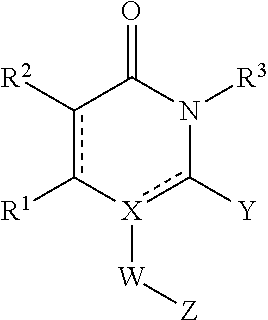Pyrimidinedione anti-viral compounds
a technology of pyrimidinedione and antiviral compounds, which is applied in the field of pyrimidinedione antiviral compounds, can solve the problems of limited antiviral drugs, large public health problems, and many poorly effective drugs, and achieves less susceptible, less side effects, and enhanced antiviral response of the hos
- Summary
- Abstract
- Description
- Claims
- Application Information
AI Technical Summary
Benefits of technology
Problems solved by technology
Method used
Image
Examples
example 1
Antiviral Activity and Pharmacological Properties of Lead KIN500 Using Quantitative Structure-Activity Relationship (QSAR) Studies
[0167]Examples of a KIN500 compound class structures are the compounds
[0168]
[0169]Unless otherwise indicated, examples utilized the structure above and to the left. Compounds of this class have antiviral activity as measured in a number of assays described below. A summary of antiviral activity of KIN500 is as follows: the HCV focus-forming assay (FFA) (IC50) value was 19.1 μM; the Influenza nucleoprotein (NP) ELISA (IC50) value was 4.6 μM; the cytotoxicity (CC50) value was >50 μM; and the Therapeutic Index (TI) (CC50 / IC50) was 11. The data are shown below in Table 5.
[0170]Further analog development is carried out for the uracil derivative KIN500, which has an 18-fold enhancement of ISG expression, and potency against influenza virus infection. The compound falls within the accepted range for all Lipinski parameters and possesses rotatable bonds and a pol...
example 2
EMCV Antiviral Assay
[0181]Huh7 cells were grown under normal growth conditions and treated with the indicated amount of drug in media containing 0.5% DMSO. The cells were grown in the presence of drug for 5 hours and then infected with 250 pfu Murine Encephalomyocarditis virus (EMCV) for example obtained from ATCC #VR-129B. Infected cells were grown for an additional 18 hours and then cell viability was measured using an MTS assay. Negative control cells were treated with buffer alone containing 0.5% DMSO. Interferon treatment was used as a positive control for virus inhibition and was added similar to drug treatments at a final concentration of 10 IU / mL for example Interferon-α: Intron A, from Schering-Plough. Cell viability was measured using an MTS assay such as; CellTiter 96® AQueous One Solution Cell Proliferation Assay (MTS), from Promega #G3580.
[0182]Results are shown in FIGS. 2A and 2B and are as follows:
[0183]
Addition (drug or control)Cell viability post-infectionNegative c...
example 3
Mechanism of Action and Antiviral Activity of KIN500 Compounds
[0184]As discussed above, a compound of the KIN500 class exhibits antiviral activity in various cell culture models. This Example is conducted to further define the activity of optimized KIN500 compounds for antiviral activity against an expanded set of RNA viruses.
[0185]Antiviral action in cell culture infection models. A compound of the KIN500 class disclosed herein has efficient activity against HCV genotype 2a and influenza virus strain WSN. To further characterize the breadth of antiviral activity of optimized KIN500 molecules, cell culture infection models are used to analyze different HCV genotypes and influenza virus strains. In addition, optimized KIN500 compounds are tested for activity against West Nile virus (WNV), an emerging public health concern. The studies include treating cells with compound 2-12 h prior to infection or treating cells 8 h after infection (Table 2). Virus production and cellular ISG expre...
PUM
| Property | Measurement | Unit |
|---|---|---|
| time | aaaaa | aaaaa |
| structure | aaaaa | aaaaa |
| viral resistance | aaaaa | aaaaa |
Abstract
Description
Claims
Application Information
 Login to View More
Login to View More - R&D
- Intellectual Property
- Life Sciences
- Materials
- Tech Scout
- Unparalleled Data Quality
- Higher Quality Content
- 60% Fewer Hallucinations
Browse by: Latest US Patents, China's latest patents, Technical Efficacy Thesaurus, Application Domain, Technology Topic, Popular Technical Reports.
© 2025 PatSnap. All rights reserved.Legal|Privacy policy|Modern Slavery Act Transparency Statement|Sitemap|About US| Contact US: help@patsnap.com



